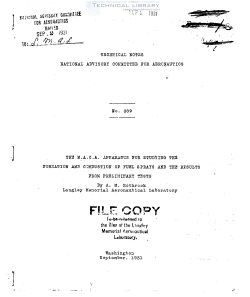naca-tn-389
- Version
- 148 Downloads
- 1.49 MB File Size
- 1 File Count
- November 24, 2016 Create Date
- November 24, 2016 Last Updated
National Advisory Committee for Aeronautics, Technical Notes - The NACA Apparatus for Studying the Formation and Combustion of Fuel Sprays and the Results from Preliminary Tests

his report describes the apparatus as designed and
constructed at the Langley Memorial Aeronautical Laborato-
ry, for studying the formation and_combustion of fuel
sprays under conditions closely simulating those occurring
in a'high—speed compression—ignition engine. The appara—
tus consists of a single—cylinder modified test engine, a
fuel—injection system so designed that a single charge of
fuel can be injected into the combustion chamber of the en-
gine, an electric driving motor, and a high—speed photo—
graphic apparatus. The cylinder head of the engine has a
vertical disk form of combustion chamber whose sides are
glass windows. When the fuel is injected into the combus—
tion chamber, motion pictures at the rate of 2000 per sec—
ond are taken of the spray formation by means of spark
discharges. When combustion takes place the light of the
combustion is recorded on the same photographic film as
the spray photographs.
The report includes the results of some tests to de—
termine the effect of air temperature, air flOW, and noz-
zle design on the spray formation. The results show that
the compresSion temperature has little effect on the pene—
tration of the fuel-spray but does affect the dispersion,
that air.velocities of about 300 feet per second are neces—
sary to destroy the core of the spray, and that the effect
of air flow on the spray is controlled to'a certain extent
by the design of the injection nozzle. The results on the
combustion of the spray show that when ignition does not
take place_until after spray cut—eff the ignition may
start almost simultaneously throughout the combustion cham—
ber or at different points throughout the chamber. When
ignition takes place before spray,cutepff the combustion
starts around the edge of the spray and then spreads
throughout the chamber.
During the last five years the National Advisory Com—
mittee for Aeronautics has published considerable informa~
tion on the.formation of fuel sprays for high-speed com—
pressionnignition engines. The majority of the investiga-
tions reported have dealt with the effects on the fuel
spray of the injection—nozzle design, of the injection sys-
tem, and of the density of the air into which the fuel has
been sprayed. Only one report has been published by the
Committee (referenco.l) on the effect of high air tempera—
tures on the formation and penetration of the fuel spray.
The tests reported in this reference, although conducted
by spraying the fuel into air at atmospheric pressure, in-
dicated the necessity of extending the researches of the
Committee to include a study of the spray formation and
penetration into air at the temperatures and densities in
the combustion chambers of high-speed compression—ignition
engines.
| File | Action |
|---|---|
| naca-tn-389 The NACA Apparatus for Studying the Formation and Combustion of Fuel Sprays and the Results from Preliminary Tests.pdf | Download |

Comment On This Post